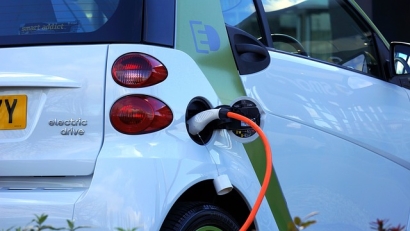
A solar charger connects to solar panels. These panels use the power of photovoltaic cells to transform sunlight into electricity, which you can then use to power your EV. Here are some of the benefits of using solar panels:
Lowering your carbon footprint since solar panels don’t produce greenhouse gases
Reducing or eliminating your electric bill
Having a reliable method of charging your car right at home — no more trips to the nearest charging station
Some EV solar chargers have small panels that only power the charging station itself. But if you install larger solar panels on your roof or the ground, you can power your entire house along with the charging station. That choice depends on your budget and the amount of available space.
There are two types of charging stations typically installed in residential areas — Level 1 and Level 2. The third type of charger is reserved for commercial use.
This is a 120v charger, which means you plug it into a regular outlet just like you’d plug in your phone. It has a slow charging speed, taking approximately 40-50 hours to fully charge a battery electric vehicle and five to six hours to recharge a plug-in hybrid.
This 240v charger requires a particular type of outlet an electrician has to install. You can often have a professional install a Level 2 charger during the solar panel installation process.
These chargers can fully power an electric vehicle in four to 10 hours and a hybrid in just one to two hours. This means you can fully charge your car overnight, which is ideal for people with long daily commutes or who travel frequently.
Also called DC fast chargers, Level 3 EV chargers are only used for industrial or commercial purposes. Installing and maintaining them requires heavy-duty, highly specialized equipment.
Homeowners must choose between a Level 1 or Level 2 solar EV charger. The most significant difference is charging speed, with Level 2 chargers being faster.
Another choice you’ll need to make is whether you connect the charging station to the energy grid.
You'll have to buy a storage battery if you decide not to connect your solar panels to the surrounding energy infrastructure. These can cost tens of thousands of dollars, but they’re necessary if you want to charge your EV — or your home, depending on the types of panels you installed — at night.
Without a battery, you’ll only get electricity in the daytime and it will be less reliable during overcast days. Most people want to charge their EVs overnight when they’re not in use.
The benefit of going off-grid is your power will stay on even if the surrounding community loses it. You can also power a home miles from any civilization. However, you’ll be in charge of storing your electricity and the battery cost alone can give some people sticker shock.
The more common option is connecting your EV charger to the nearby infrastructure. You’ll pay a service fee, but if your solar panels generate enough electricity to cover your energy needs, you won’t pay an energy bill. Additionally, some states and countries have net metering programs. This means that if you produce more electricity than you need, the energy company will give you credits for it, applying them to your next bill.
Any time you need to use more power than usual — or use energy at night, which you’ll likely be doing by charging your EV — the electric company will cover the cost by using credits. You’re essentially supplying them with excess energy, so they’re reimbursing you. This makes it virtually free to charge your car.
Considering the lifetime savings, environmental benefits and convenience of having a charging station at home, going solar makes sense for electric vehicle owners. Whether connected to the grid or not, personal solar panels reduce the range anxiety many new EV owners feel by providing a reliable power source, making it easier than ever to go green.

